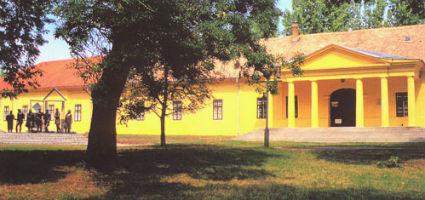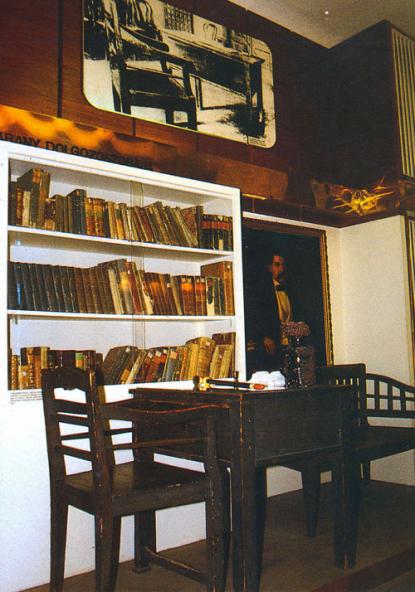2024. April 26. Friday
János Arany Museum Collection and Exhibition Room - Nagykőrös
 |
Address: 2750, Nagykőrös Ceglédi út 19.
Phone number: (20) 950-9560, (53) 583-553
E-mail: muzeum@korosikultura.hu
Opening hours: 01.04-30.11.: Thu-Sat 13-17
|
Museum tickets, service costs:
|
Ticket for adults
|
600 HUF
|
|
|
Ticket for students
|
300 HUF
|
|
|
Ticket for pensioners
|
300 HUF
|
|
|
Guide for adults
|
6000 HUF
|
|
|
Guide for students
|
3000 HUF
|
The title of the exhibition comes from a folk song once heard by János Arany in the "Idle" bleaks of Nagykőrös. The permanent exhibition presents the town of Nagykőrös focusing on János Arany who was born in this town.

A gold studded sword from before the Original Settlement is of unparalleled value. Belt studs and arrow fractures are known from the era of the Original Settlement. Several churches existed in the Nagykőrös region in the Árpád Age. During the 14-15th century these were depopulated which led to Nagykőrös acquiring more significance. The new frontiers provided excellent conditions for agriculture. The so-called Christ with Corpus with Feather Crown used at processions in Ludas in the 13th century is of unique value.
During Turkish subjection (1541-1686) Nagykőrös was an important centre of economics and society. Tools used at animal husbandry, relics of advanced artisanship (eg silver seal from 1617, silver guild cup from 1629 and the Goldsmith Guild’s Seal from 1666.
New guild organizations were founded in the 18th century and the beginning of the 19th century (eg. smiths, carpenters etc). Ornamented wrought iron tools represent agriculture. The digging plough is of curiosity, as well as the scale model of the dry mill and tools used in the famous viniculture of Nagykőrös.
The town supported the spirits of the Revolution of 1848 as one. But not just in spirit. Several people from Nagykőrös joined the regular army. In the autumn of 1848, the 13. Hussar regiment was recruited, later on the 16. Károlyi Regiment.
After the failure of the War of Independence, the town of Nagykőrös outstood with nursing national culture at its Reformed Grammar School. János Arany arrived in town in November 1851. He worked as a teacher at the grammar school until 1860. He and his colleagues turned the town of Nagykőrös into a center of culture. Seven of his fellows became members of the Hungarian National Academy. An superior section named for János Arany deals with the spiritual heydays of Nagykőrös. The showing also includes essays corrected by János Arany, as well as family documents and objects. Literature related documents are also on display, eg the manuscript of the "Gypsies of Nagyida" "Katalin" and the "Grass of Saint László". János Arany mostly wrote his literary masterpieces in Nagykőrös, among them the Hunyadi Ballads.
Dr. László Ferenc Novák

A gold studded sword from before the Original Settlement is of unparalleled value. Belt studs and arrow fractures are known from the era of the Original Settlement. Several churches existed in the Nagykőrös region in the Árpád Age. During the 14-15th century these were depopulated which led to Nagykőrös acquiring more significance. The new frontiers provided excellent conditions for agriculture. The so-called Christ with Corpus with Feather Crown used at processions in Ludas in the 13th century is of unique value.
During Turkish subjection (1541-1686) Nagykőrös was an important centre of economics and society. Tools used at animal husbandry, relics of advanced artisanship (eg silver seal from 1617, silver guild cup from 1629 and the Goldsmith Guild’s Seal from 1666.
New guild organizations were founded in the 18th century and the beginning of the 19th century (eg. smiths, carpenters etc). Ornamented wrought iron tools represent agriculture. The digging plough is of curiosity, as well as the scale model of the dry mill and tools used in the famous viniculture of Nagykőrös.
The town supported the spirits of the Revolution of 1848 as one. But not just in spirit. Several people from Nagykőrös joined the regular army. In the autumn of 1848, the 13. Hussar regiment was recruited, later on the 16. Károlyi Regiment.
After the failure of the War of Independence, the town of Nagykőrös outstood with nursing national culture at its Reformed Grammar School. János Arany arrived in town in November 1851. He worked as a teacher at the grammar school until 1860. He and his colleagues turned the town of Nagykőrös into a center of culture. Seven of his fellows became members of the Hungarian National Academy. An superior section named for János Arany deals with the spiritual heydays of Nagykőrös. The showing also includes essays corrected by János Arany, as well as family documents and objects. Literature related documents are also on display, eg the manuscript of the "Gypsies of Nagyida" "Katalin" and the "Grass of Saint László". János Arany mostly wrote his literary masterpieces in Nagykőrös, among them the Hunyadi Ballads.
Dr. László Ferenc Novák
